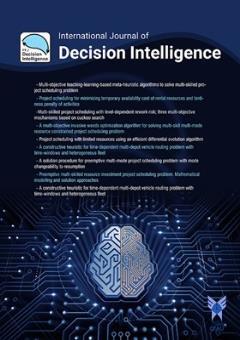About the journal
If we make this decision today, then what will happen in the future? If we make a decision at this place how is it going to impact the other places? Decision Intelligence (DI) is an emerging field which provides a framework for best practices in decision-making and processes for applying Machine Learning and Artificial Intelligence (AI) at scale. More specifically, DI provides a framework which decision makers may somewhat know, prior to making any decision, what is going to happen in the future if they make a particular decision today.
The International Journal of Decision Intelligence (IJDI) welcomes submissions of DI's applications in various areas: Intelligent Cities, Industries, Medical Treatment and Health, Agriculture, Business and Finance, Internet of Things (IoT) and Operations Management. Research including DI's applications in other fields is also encouraged.
Recent Articles
-
Open Access Article
1 - Comparison and application of multi-criteria decision making methods in the selection of construction projects (Study of Gostar Mehr Atlas project)
Mahdi Ranjbarzade *Issue 4 , Vol. 1 , Autumn 2024 -
Open Access Article
2 - Using deep convolutional neural network to diagnose covid-19 disease from CT scan images
Rezvaneh Azizi * ، Hamid AbbasiIssue 4 , Vol. 1 , Autumn 2024 -
Open Access Article
3 - Data Security and Privacy Challenges in IoT-Enabled Smart Cities: A Comprehensive Survey
Safoura Akhlaghi * ، Mohammad bagher Menhaj ، behrooz masoumiIssue 4 , Vol. 1 , Autumn 2024 -
Open Access Article
4 - Enhancing Municipal Revenue Processes: A Case Study on Process Mining Approaches in Hamedan Province
Mohammad Amin Jafari * ، Mansour EsmaeilpourIssue 4 , Vol. 1 , Autumn 2024 -
Open Access Article
5 - Human Behaviors against COVID-19: A game theory approach and a case study of Iran
Mansour Abedian * ، Maryam Hejazi ، Sayyed Mohammad Reza DavoodiIssue 4 , Vol. 1 , Autumn 2024 -
Open Access Article
6 - Diagnosis of Parkinson's Disease Using EEG Signals and Machine Learning Techniques: A Comprehensive Study
Maryam Allah Bakhshi * ، Aylar Sadri ، Seyed Omid ShahdiIssue 4 , Vol. 1 , Autumn 2024
Most Viewed Articles
-
Open Access Article
1 - Diagnosis of Parkinson's Disease Using EEG Signals and Machine Learning Techniques: A Comprehensive Study
Maryam Allah Bakhshi * ، Aylar Sadri ، Seyed Omid ShahdiIssue 4 , Vol. 1 , Autumn 2024 -
Open Access Article
2 - A Network Data Envelopment Analysis Approach for Efficiency Measurement of Poultry Industry Production Chains
Ali Taherinezhad ، Alireza Alinezhad * ، Saber Gholami ، Mahsa AbdolvandIssue 2 , Vol. 1 , Spring 2024 -
Open Access Article
3 - Optimal Prediction in the Diagnosis of Existing Heart Diseases using Machine Learning: Outlier Data Strategies
Omid Rahmani * ، Seyyed Amir Mahdi Ghoreishi Zadeh ، Mostafa SetakIssue 2 , Vol. 1 , Spring 2024 -
Open Access Article
4 - Presenting a Fuzzy Expert System for Diagnosis of Diabetes
Abolfazl Kazemi * ، Ali MohammadiIssue 1 , Vol. 1 , Winter 2024 -
Open Access Article
5 - Robust Parameters Design of Categorical Responses under Modeling and Implementation Errors
Milad Zamani ، Arezoo Borji ، Taha-Hossein Hejazi *Issue 2 , Vol. 1 , Spring 2024 -
Open Access Article
6 - Developing a Decision Model as Budget Assignment Method for Locating Industrial Facilities: Real Case Study
Parsa Fallah Sheikhlari ، Seyed Habib A Rahmati *Issue 1 , Vol. 1 , Winter 2024 -
Open Access Article
7 - A Hybrid Type-2 Fuzzy-LSTM Model for Prediction of Environmental Temporal Patterns
Aref Safari * ، Rahil HosseiniIssue 2 , Vol. 1 , Spring 2024 -
Open Access Article
8 - Explanatory and Statistical Analysis for Top-Level Kata Competitions in Karate-1 Events
Md Mashum Billal * ، Tazrin Jahan PriyankaIssue 1 , Vol. 1 , Winter 2024 -
Open Access Article
9 - Enhancing Lung Cancer Diagnosis Accuracy through Autoencoder-Based Reconstruction of Computed Tomography (CT) Lung Images
Mohammad Amin Pirian ، Iman Heidari ، Toktam Khatibi * ، Mohammad Mehdi SepehriIssue 3 , Vol. 1 , Summer 2024 -
Open Access Article
10 - A Novel Supply Chain Network Design Considering Customer Segmentation using Lagrangian Relaxation Algorithm
Seyed Reza Mirmajlesi ، Donya Rahmani * ، Reza BashirzadehIssue 2 , Vol. 1 , Spring 2024




